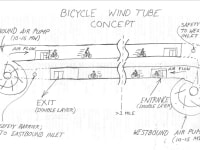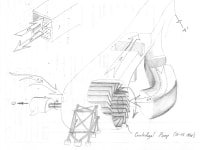Most people who have ridden bicycles can attest that air resistance is the main barrier to achieving a desirable average speed.
Alternatively, many science-minded people who are familiar with the Mythbusters television show may recall that bicycles can draft trucks (of rectangular rear end) at speeds which are nearly impossible to attain with human power alone. The wake of the truck, which is fully turbulent, can be fully reproduced in a Bicycle Wind Tube (BWT).
The Bicycle Windtube is a structure specifically suited for the human-powered bicycle mode of transportation, capable of sustaining an average air speed of 25 miles per hour inside of a closed tunnel. This number seems insignificant but may represent a 'tipping point' in the bicycle mode uptake, for reasons to be explained.
The Windtube described here is a box-tube split into two top and bottom internal rectangular chambers, which measure 10 feet by 20 feet in dimension. The top and bottom chambers would have opposite airflow velocity. A one-way chamber measuring 20 feet across can be divided into about 6 lanes of bicycles traffic, or 4 lanes with two shoulders. The structure is made from prestressed concrete, and can be rapidly assembled from pre-fabricated sections. The average speed of the airflow is 25 miles per hour.
Large centrifugal air pumps (about two stories tall) are situated at the ends of the Windtube tunnel to generate the airflow. The opposing airflow constitutes about 75% of the pump inlet, with the remaining 25% fresh air. There are emergency vents which can be automatically opened in the case of fire or other hazards.
Calculations using the Crane Handbook (Technical Paper No. 410: Flow of Fluids Through Valves, Fittings, and Pipe) have determined two key important characteristics about the Windtube:
First, the airflow is fully turbulent, with a Reynolds number over 10E6. This means that the velocity profile develops rapidly from the wall inwards, reaching a maximum by about one lane's width from the wall. Thus, the airflow can benefit at least 4 lanes of bicycle traffic, with the side lanes being used either for slower traffic or shoulder space.
Second, the required power of a centrifugal air pump (as calculated from the pressure drop over 25 miles) is calculated to be approximately 13 MW. This result assumed only one pump, situated at the end of a tube with no bi-directional air recycling, and thus represents a conservative estimate. The power is equivalent to about 17,000 horsepower, which equals ~150 cars. The Wind tube can obviously hold far more riders than this every 25 miles. Because people can return energy to the airflow simply by pedaling until they feel relative headwind, the load on the air pumps is less than 13 MW. It is expected that most cyclists will give back more energy to the airflow than they consume over their entire trip.
References:
1. Bike Drafting Minimyth: Mythbusters. Discovery Channel, 2007.
2. Flow of Fluids through Valves, Fittings, and Pipe. Technical Paper No. 410, Crane Co., 1981.
Voting
-
ABOUT THE ENTRANT
- Name:Brian Chow
- Type of entry:individual
- Profession:
- Number of times previously entering contest:1
- Brian's favorite design and analysis tools:Hand calculation, SAP2000, Solidworks (with Simulation), Matlab, Octave, and NASTRAN.
- Brian's hobbies and activities:Bicycling, Arithmetic, and Rock Collecting
- Brian belongs to these online communities:Bikeforums, Skyscrapercity forums, Sciforums
- Brian is inspired by:I sometimes have ideas when I feel that something is missing from an activity, object, or system.
- Patent status:none








